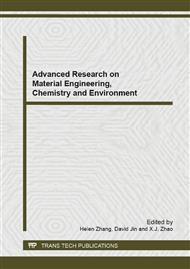p.383
p.387
p.392
p.396
p.400
p.405
p.409
p.413
p.418
Study on Environment Engineering with Influence of Human Factors on the Temperature Variation in Beijing City
Abstract:
with the rapid development of our economy, the problem of environmental pollution is becoming more and more serious. the temperature is an important embodiment of environmental quality. In recent years, the trend of temperature variation in Beijing city is relatively stable. There are many factors that influence the temperature change, such as the astronomical factors, geographical factors. Using the grey relational theory, this paper analyzed the impact of human factors on climate change in Beijing city. Results show that, in accordance with the influence factors for temperatures from big to small order, influence factors are as follows: the number of resident population, energy consumption, GDP, investment in science and technology, education investment. Therefore , we need to focus on population control and reduce energy consumption quantity to keep the temperature of Beijing city stable. In this way, we can improve the environment quality of Beijing.
Info:
Periodical:
Pages:
400-404
Citation:
Online since:
September 2013
Authors:
Keywords:
Price:
Сopyright:
© 2013 Trans Tech Publications Ltd. All Rights Reserved
Share:
Citation:


